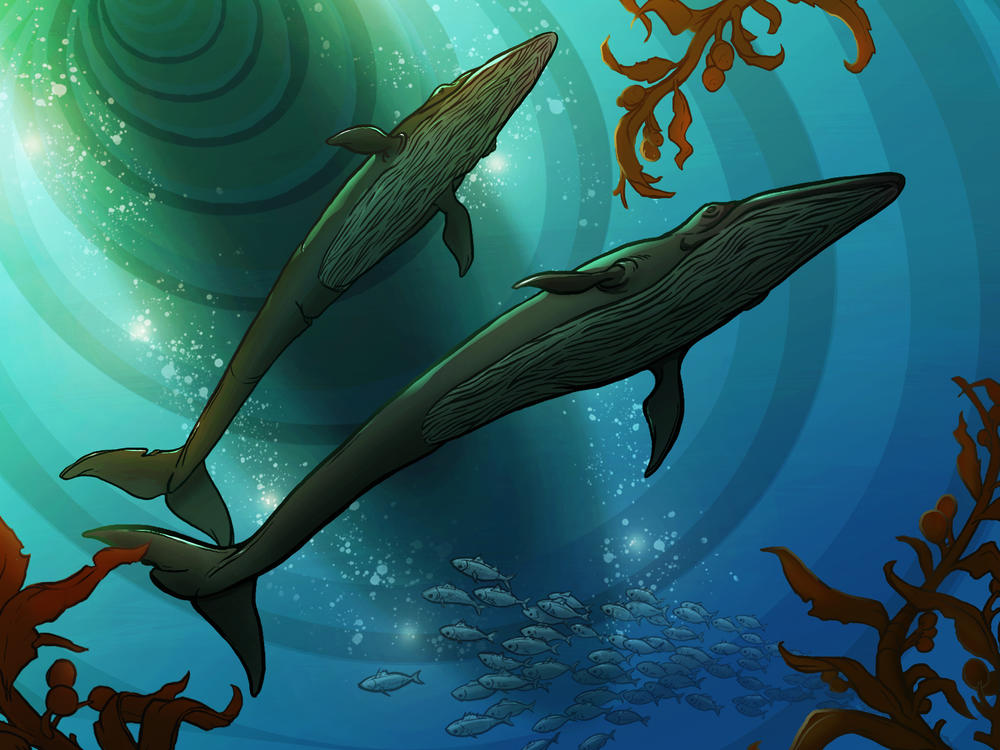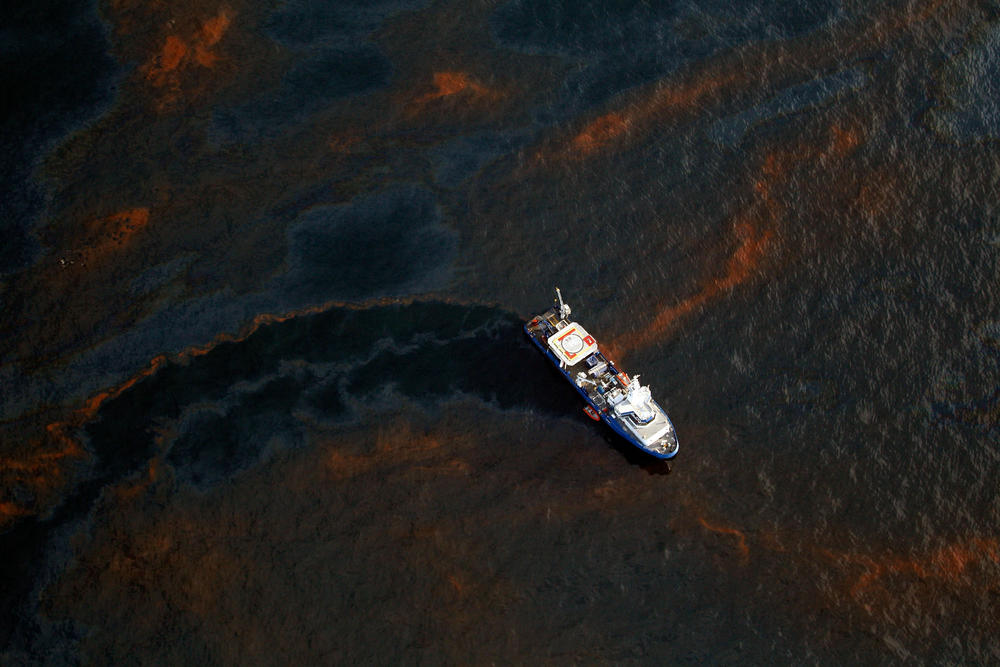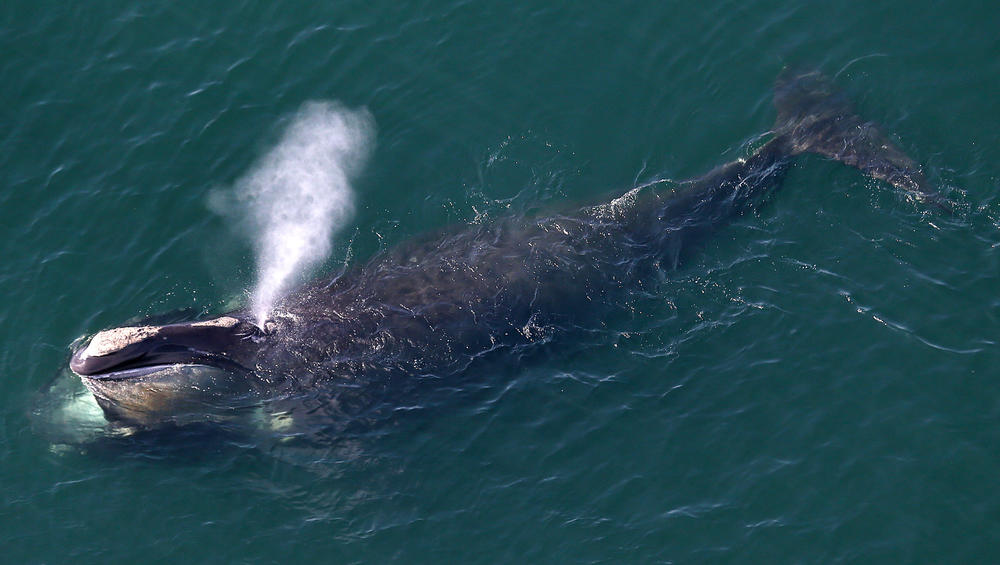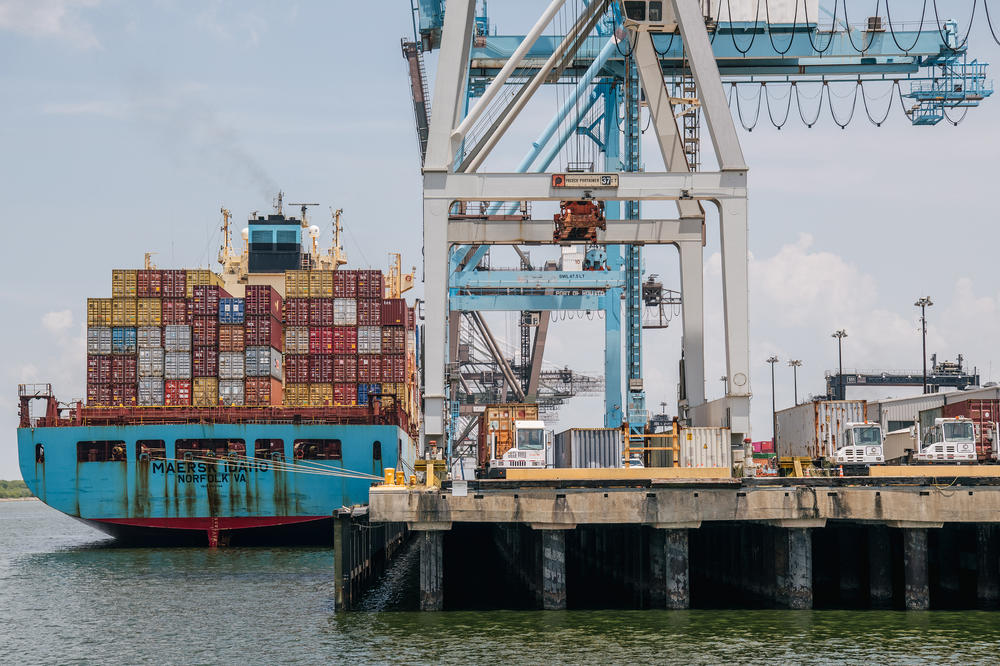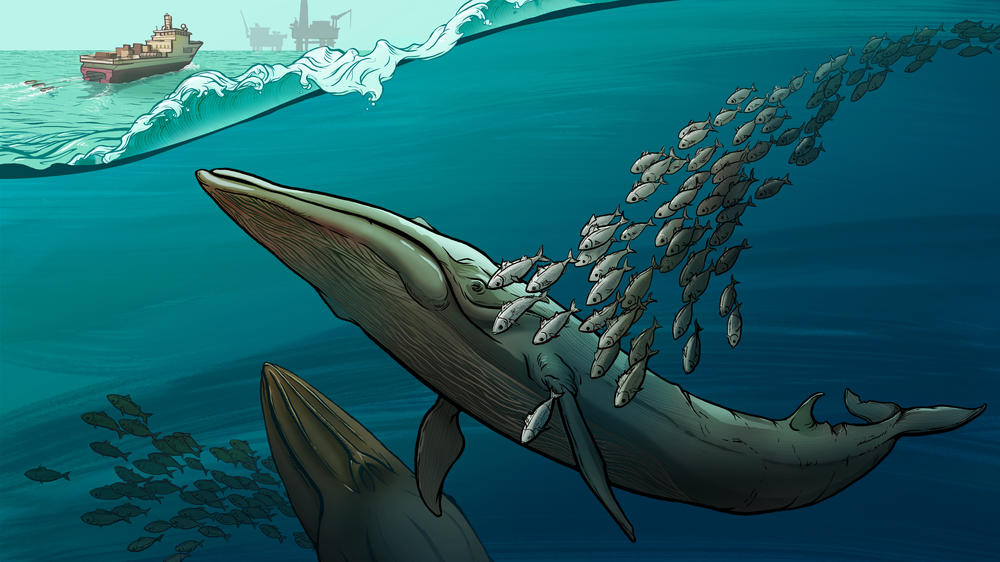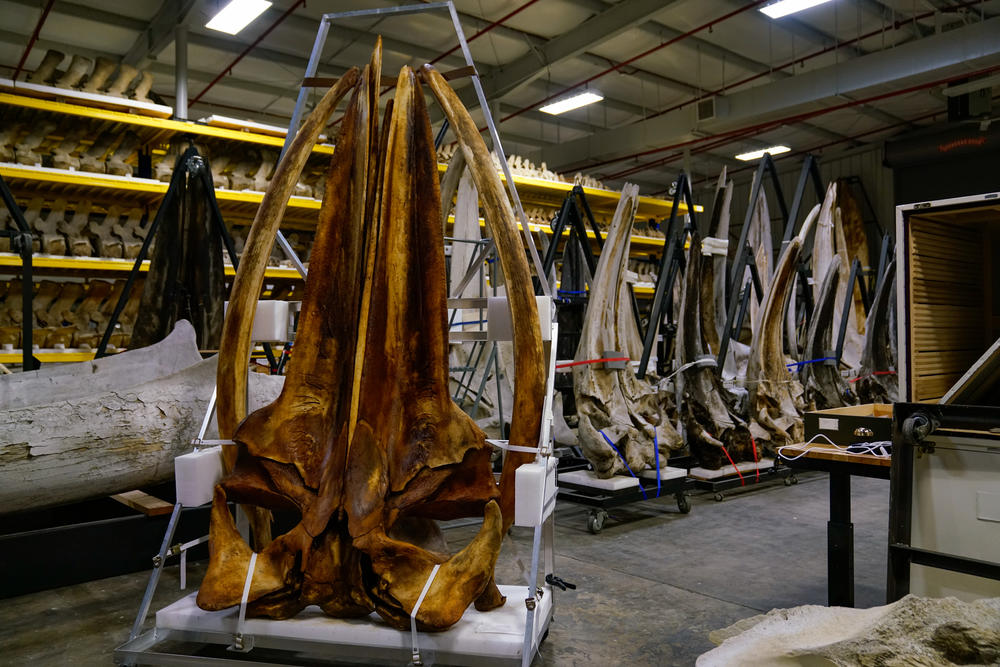Loading...
Section Branding
Header Content
Only 51 of these U.S. whales remain. Little has been done to prevent their extinction
Heard on
Primary Content
Even before they saw one of the rarest mammals in the Gulf of Mexico, the two amateur fishermen were already feeling lucky. They had motored to their favorite spot 35 miles off the coast of Pensacola, Fla., downed a couple Miller Lites, and caught their third mahi mahi when they heard the sound of air escaping a blowhole.
"Then you start looking," said Ben Renfroe, who grabbed his phone to film it. "Is that a dolphin or a whale?"
But dolphins in the Gulf don't grow bigger than motorboats, and the dark figure Renfroe spotted just before it sank back into the water looked much larger than his 26-foot craft. Seconds later, the animal appeared above the horizon again, first showing off a small dorsal fin, then gliding its trunk over the waves like a surfacing submarine.
Back on shore, experts reviewed the video and agreed: It was almost certainly a Rice's whale, one of the most endangered whales in the world. Authorities estimate only around 51 of the animals remain – and they don't live anywhere but the Gulf. To avoid extinction, the U.S. government has estimated that no more than one can be killed or seriously injured by human activity every 15 years.
Which activities threaten the whales the most is not a mystery. The National Oceanic and Atmospheric Administration, or NOAA, has cited more than 20 risks, including energy exploration in the Gulf, vessel strikes and underwater noise. But although the agency has produced helpful science about the whales, NOAA has repeatedly delayed following rules and adopting measures that could help the whales survive those man-made threats.
"The bureaucratic apparatus is slow to catch up," said Aaron Rice, an ecologist who studies the whales but is not related to scientist Dale Rice, for whom they are named. "It raises this philosophical question of values, like, how much do we value these animals that live in U.S. waters?"
"Shameful" delays for protections
On April 20, 2010, about 40 miles offshore from Louisiana, the BP drilling rig Deepwater Horizon caught fire. Within two days, 11 workers had died and the rig had sunk. The well that was left behind would gush more than 200 million gallons of oil into the Gulf of Mexico over the next three months. It was the largest marine oil spill in history.
Rice's whales were some of the animals most harmed by the disaster. About one in five died after the oil slick engulfed their habitat, and those that survived became more likely to get sick or lose pregnancies. Their numbers dropped to fewer than 100.
But the spill also prompted more attention to the whales. Before Deepwater Horizon, the animals were thought to be a type of Bryde's whale, a kind of whale found everywhere from South Africa to Japan. After the disaster, researchers from NOAA and other groups analyzed bones that washed up on Gulf shores and conducted genetic tests. This was no subgroup, they soon realized. This was a completely new species. The ones in the Gulf were believed to be the last ones left on the planet.
The newest great whale was also one of the most endangered, and it was right in America's backyard.
"Every animal counts at that point," said Jane Davenport, a senior attorney at Defenders of Wildlife, a conservation nonprofit. "Every one you kill is another nail in the coffin."
Losing the species would mean losing an animal that fuels the ocean's productivity by transferring nutrients from the seafloor to the surface, and back again, with every dive. Great whales also reduce carbon emissions. When they die, they sink an average of about 33 tons of CO2 that they've stored in their bodies throughout their life to the bottom of the ocean. That's more than 1,000 times the carbon a tree captures in a year. Experts say the whales' extinction would be an ominous indicator of an unhealthy Gulf ecosystem.
And it would be a reflection of slow U.S. action to protect the whales. Federal laws mandate that NOAA list a marine mammal as endangered soon after a species is shown to be at risk with the best scientific data available. Typically no more than one year after the species is listed, the agency must also determine what habitat the animal needs to be protected. That earns both the animals and their physical home special consideration when projects are proposed nearby that could harm them – a constant threat in the Gulf. Nearly all the U.S. oil and gas extracted offshore is pulled from the Gulf of Mexico; industrial activity is a fixture of the area.
But NOAA has been years late meeting its deadlines, and though the whales were eventually added to the endangered species list, it still hasn't designated the whales' habitat. Conservation nonprofits have sued the agency three times since 2016 to urge it to comply with the law.
The agency is also required to publish a plan for how the government intends to help the Rice's whale population recover to healthy numbers. NOAA hasn't done that yet either, though the agency has released an eight page outline.
The chief of NOAA's marine mammal branch in the Southeast, Laura Engleby, said the agency is limited by its staff and resources, and is doing the best it can to help the animals. She said the agency is in the middle of several restoration projects and is conducting outreach to spread awareness of the whale's dwindling numbers. In November, a part of a skeleton that helped scientists determine that Rice's whales were a new species will be added to a public exhibit at the Smithsonian National Museum of Natural History in Washington, D.C.
But Michael Jasny, a senior policy analyst for Natural Resources Defense Council, one of the nonprofits that has brought the agency to court for missing protection deadlines, said the repeated delays should be considered scandalous.
"It's an extreme case showing the extent to which an agency will delay," said Jasny. "And that is really shameful, given that the species that are being managed are on the verge of extinction."
Ships remain serious threat to whales, NPR analysis shows
In 2021, a group of nonprofits grew tired of waiting for NOAA to act. They petitioned the agency to impose a speed limit to protect the animals from at least one of their immediate man-made threats: ships.
Gulf ports are busy; the port of Houston exports more tons of cargo than any other port in the country. Since 2009, two Rice's whales have been killed or injured after ships hit them. And research on whales injured by ships over the past few decades shows that the strikes that seriously harm the mammals are often caused by big vessels that are moving quickly.
So the environmental groups recommended that when ships 65 feet or larger cross a portion of the whales' habitat in the eastern Gulf, they be required to slow down to 10 knots or less. They also asked the agency to prohibit travel in that zone under the Florida panhandle at night, when the whales float near the surface and are harder to spot.
Slowing down ships to save whales isn't a new idea. North Atlantic Right whales are also endangered; around 350 are estimated to remain in the American and Canadian Atlantic. Along the U.S. East Coast, a 10-knot limit has been in place to protect them for more than a decade. Research indicates that lowering speeds to that level works.
"Vessel speed is the low-hanging fruit," said Davenport, the lawyer for Defenders of Wildlife, one of the nonprofits that petitioned NOAA. "That is the most important thing that we can do right now."
But after NOAA invited public comments on the proposal this summer, the energy and marine industries pushed back fiercely – and politicians who represent states where those sectors are top employers drafted legislation against it.
On Aug. 18, Rep. Clay Higgins, R-La., proposed a House bill that would block NOAA from passing the speed limit until the government could show it wouldn't negatively impact commerce. A Senate version of the bill was later introduced by Sen.Bill Cassidy, R-La.
Cary Davis, the president of the American Association of Port Authorities, a seaport industry advocacy group, told NPR that a limit for just a few Rice's whales in the Gulf didn't make sense.
"It's wildly overbroad and ill-conceived to force a blanket slow-down if there's only so many of them," Davis said. "And time is money, of course."
After reviewing the feedback, on Oct. 27, NOAA announced its decision. It denied the nonprofits' speed limit petition.
In a statement, the agency said it needed to focus on other conservation priorities, and would try to get vessel operators to slow down voluntarily. But without a mandatory limit, the risk of ships injuring the whales is high across the Gulf.
NPR analyzed traffic data for over 6,000 ships that were 65 feet and larger. The data, collected by land and satellite receivers, indicated where the ships went and how fast they were going as they traveled across the 28,000-square-mile swath of the whales' proposed critical habitat in 2022.
Out of all the journeys the ships took that crossed the whales' habitat last year, 80% were traveling at an average of more than 10 knots. Without a limit in place, vessel speeds could continue to be a serious threat to the whales.
Environmentalists called NOAA's denial of the slow-down petition absurd, given that ship strikes had already injured more Rice's whales in the past 15 years than the government has said the species could afford to lose if it hoped to avoid extinction.
"To engage in yet more delay while the agency pursues paperwork is just an utter failure in conservation," said Jasny, from NRDC. "I find no way to read this other than as an act of political cowardice."
When it comes to underwater noise, another established threat to the whales, there are also few limits.
No noise limits
Rice's whales let out deep, low moans that pulsate underwater for up to a minute.
Scientists say the calls are unique – nothing on the planet sounds like them – and that the whales may make them to survive. Marine mammals use their hearing to find mates and food, to maintain relationships, to navigate and to avoid predators.
But the Gulf is one of the loudest places underwater in the U.S.
Fast ships don't just hit whales. At speeds of over 10 knots ship propellers start to generate intense cavitation noise. That sound causes most of the underwater sound pollution from the shipping industry, said Andrew Kendrick, a naval architect and consultant for the Canadian government. And when it happens near the whales, "they can't hear themselves think."
Scientists have observed that Rice's whales have sometimes stopped making their own sounds in the presence of ships. But the noise from seismic air gun surveys is still more powerful.
Air gun blasts are one of the most prevalent underwater sounds in the Gulf, and they overlap with the low frequency range in which Rice's whales communicate. Because sound travels faster in water than in air, researchers have picked up the blasts on recorders located more than 400 miles away – about half the length of the Gulf.
"There is just this constant blanket of human noise," said Rice, the ecologist.
And the air guns are not just noisy. When they're dragged behind vessels to help identify the location of the oil and gas, they send explosions of compressed air into the water, for weeks at a time. Those blasts, which go off every 10 seconds, send waves of pressure downward powerful enough to penetrate miles beneath the bottom of the seafloor.
Technological alternatives do exist that can be less disruptive. Some air gun technologies that can survey the ocean up to ten times more quietly than conventional guns are on the market now. Brands sell kits that can transform old guns into quieter ones, which is cheaper than replacing every gun on the ship.
Upgrading the technology isn't inexpensive. It can cost up to 10 million dollars, said representatives from Sercel, a company that sells both conventional air guns and alternatives that are friendlier to marine mammals. But that's a tiny fraction of the income generated by just four of the largest energy companies working in the Gulf. Chevron, ExxonMobil, Shell and BP earned more in 2022 than any other year in history. Collectively, they earned around 160 billion dollars.
Still, the government doesn't require the industry to use alternatives. Though excessive noise is prohibited on land, there are no limits to the amount of noise that can be sent into the ocean.
"If the regulations aren't there," said Robin Ellis, a vice president of sales at Sercel, "they're not going to do it."
After reviewing public documents, NPR found that's the case in the Gulf. Of the 25 seismic survey projects that have cumulatively been approved to blast noise into the ocean for more than 1,000 days over the next three years, all but two energy companies have said they will use conventional airgun systems that stream multiple guns behind their boats.
Harming whales is not the industry's goal, said Alex Loureiro, the scientific director for EnerGeo Alliance, a trade association that represents oil and gas companies. The alternative technologies are just not as efficient, she said.
"It's going to take time for the industry to actually be able to use these technologies effectively," said Loureiro.
When asked whether NOAA was doing anything to encourage industries to switch to quieter technologies that are better for whales, an agency representative pointed NPR to a document that said it wanted to reduce noise, but listed few concrete steps for changing the rules.
Environmental groups and scientists think sightings of Rice's whales may become increasingly rare. In an open letter to the Biden administration they predicted a serious consequence if conservation action is not taken quickly: the first man-made extinction of a great whale species could happen under U.S. watch.
In October, Ben Renfroe and his friend put the prediction to the test. They went looking again for the Rice's whales, hoping to repeat their summer luck. The two spent almost 10 hours in the mammals' habitat, motoring more than 100 miles around the Gulf of Mexico. They spotted a few birds and accidentally hooked a shark with their fishing pole.
But this time, they saw little else. No blowholes. No fins. No sign of any whales.
Methodology
NPR downloaded Automatic Identification Systems (AIS) ship transponder data from MarineCadastre.gov, a cooperative effort between the Bureau of Ocean Energy Management and the National Oceanic and Atmospheric Administration (NOAA). This AIS data is collected by approximately 200 land-based receiving stations from the U.S. Coast Guard's Nationwide Automatic Identification System. As the range of land receivers is usually limited to 40-50 miles off the coast, the data was combined with satellite-collected AIS data from Spire and processed by Global Fishing Watch to provide more comprehensive coverage of the Gulf of Mexico.
In NPR's analysis of transits through the proposed critical habitat of the Rice's whales, a transit was defined as an instance when a ship entered or exited the area. A new transit was also started if there was more than a day's gap between two AIS broadcast points.
The speed of a transit through the critical habitat was calculated using a distance-weighted average speed, as detailed in a vessel speed rule assessment published by NOAA. This method corrects for variations in AIS transmission and reception rates, which can be influenced by the speed and type of the vessel.
Ships measuring less than 65 feet in length as well as law enforcement, search and rescue, and military vessels, were excluded from this analysis.
Access the code here.
NOAA Fisheries encourages all boaters, anglers and others operating in Gulf of Mexico waters to report all suspected sightings of Rice's whales by calling 877-WHALE-HELP (877-942-5343).
This reporting was supported in part by a grant from the Institute for Journalism & Natural Resources, a nonprofit that supports journalists covering the environment.
Barrie Hardymon edited this story and Noah Caldwell produced it. Robert Little and Graham Smith contributed editing and producing support. Research from Barbara Van Woerkom, and art direction and photo editing by Emily Bogle. Graphic by Daniel Wood.
Copyright 2023 NPR. To see more, visit https://www.npr.org.
